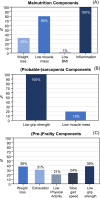Multimorbidity and the risk of malnutrition, frailty and sarcopenia in adults with cancer in the UK Biobank
- PMID: 39358315
- PMCID: PMC11446695
- DOI: 10.1002/jcsm.13523
Multimorbidity and the risk of malnutrition, frailty and sarcopenia in adults with cancer in the UK Biobank
Abstract
Background: Malnutrition, sarcopenia and frailty are distinct, albeit interrelated, conditions associated with adverse outcomes in adults with cancer, but whether they relate to multimorbidity, which affects up to 90% of people with cancer, is unknown. This study investigated the relationship between multimorbidity with malnutrition, sarcopenia and frailty in adults with cancer from the UK Biobank.
Methods: This was a cross-sectional study including 4122 adults with cancer (mean [SD] age 59.8 [7.1] years, 50.7% female). Malnutrition was determined using the Global Leadership Initiative on Malnutrition criteria. Probable sarcopenia and sarcopenia were defined using the European Working Group on Sarcopenia in Older People 2 criteria. (Pre-)frailty was determined using the Fried frailty criteria. Multimorbidity was defined as ≥2 long-term conditions with and without the cancer diagnosis included. Logistic regression models were fitted to estimate the odds ratios (ORs) of malnutrition, sarcopenia and frailty according to the presence of multimorbidity.
Results: Genitourinary (28.9%) and breast (26.1%) cancers were the most common cancer diagnoses. The prevalence of malnutrition, (probable-)sarcopenia and (pre-)frailty was 11.1%, 6.9% and 51.2%, respectively. Of the 11.1% of participants with malnutrition, the majority (9%) also had (pre-)frailty, and 1.1% also had (probable-)sarcopenia. Of the 51.2% of participants with (pre-)frailty, 6.8% also had (probable-)sarcopenia. No participants had (probable-)sarcopenia alone, and 1.1% had malnutrition, (probable-)sarcopenia plus (pre-)frailty. In total, 33% and 65% of participants had multimorbidity, including and excluding the cancer diagnosis, respectively. The most common long-term conditions, excluding the cancer diagnosis, were hypertension (32.5%), painful conditions such as osteoarthritis or sciatica (17.6%) and asthma (10.4%). Overall, 80% of malnourished, 74% of (probable-)sarcopenia and 71.5% of (pre-)frail participants had multimorbidity. Participants with multimorbidity, including the cancer diagnosis, had higher odds of malnutrition (OR 1.72 [95% confidence interval, CI, 1.31-2.30; P < 0.0005]) and (pre-)frailty (OR 1.43 [95% CI 1.24-1.68; P < 0.0005]). The odds increased further in people with ≥2 long-term conditions in addition to their cancer diagnosis (malnutrition, OR 2.41 [95% CI 1.85-3.14; P < 0.0005]; (pre-)frailty, OR 2.03 [95% CI 1.73-2.38; P < 0.0005]). There was little evidence of an association of multimorbidity with sarcopenia.
Conclusions: In adults with cancer, multimorbidity was associated with increased odds of having malnutrition and (pre-)frailty but not (probable-)sarcopenia. This highlights that multimorbidity should be considered a risk factor for these conditions and evaluated during nutrition and functional screening and assessment to support risk stratification within clinical practice.
Keywords: cancer; frailty; malnutrition; multimorbidity; sarcopenia.
© 2024 The Author(s). Journal of Cachexia, Sarcopenia and Muscle published by Wiley Periodicals LLC.
Conflict of interest statement
C.M.P. reports receiving honoraria and/or paid consultancy from Abbott Nutrition, Nutricia, Nestle Health Science, Fresenius Kabi, Pfizer and AMRA Medical. N.K., L.D., S.F.F., L.E., B.J.B., G.A., R.M.D. and A.K. have no conflicts of interest to report.
Figures




References
-
- Sung H, Ferlay J, Siegel RL, Laversanne M, Soerjomataram I, Jemal A, et al. Global cancer statistics 2020: GLOBOCAN estimates of incidence and mortality worldwide for 36 cancers in 185 countries. CA Cancer J Clin 2021;71:209–249. - PubMed
-
- Baracos VE. Cancer‐associated malnutrition. Eur J Clin Nutr 2018;72:1255–1259. - PubMed
-
- Blauwhoff‐Buskermolen S, Versteeg KS, de van der Schueren MA, Braver NR, Berkhof J, Langius JAE, et al. Loss of muscle mass during chemotherapy is predictive for poor survival of patients with metastatic colorectal cancer. J Clin Oncol 2016;34:1339–1344. - PubMed
-
- Marshall KM, Loeliger J, Nolte L, Kelaart A, Kiss NK. Prevalence of malnutrition and impact on clinical outcomes in cancer services: a comparison of two time points. Clin Nutr 2019;38:644–651. - PubMed
MeSH terms
Grants and funding
LinkOut - more resources
Full Text Sources
Medical

